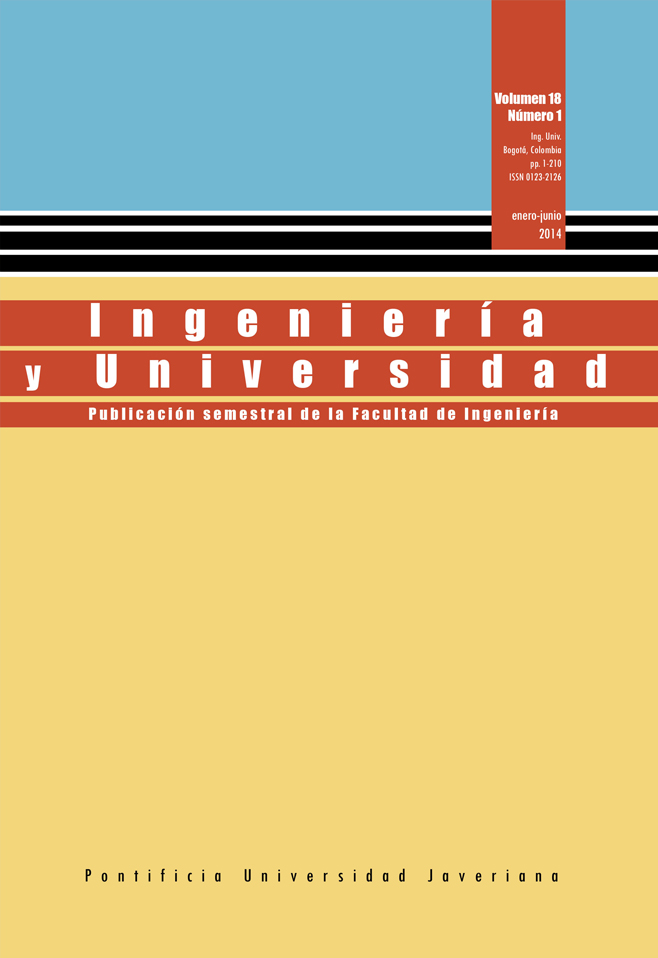Resumen
Diversos patrones de movimiento se pueden identificar cuando se estudia un conjunto de entidades en movimiento. Uno de estos patrones se conoce como formación en V ya que su forma se asemeja a dicha letra. Informalmente, un conjunto de entidades exhibe una formación en V si las entidades están ubicadas en una de sus dos líneas características. En este artículo, se presenta un modelo para identificar formaciones en V con outliers. Un outlier es una entidad que hace parte de la formación pero que está alejada de sus líneas características. Se presentan las reglas formales del modelo y un algoritmo para la detección de outliers. El modelo se validó mediante NetLogo, un entorno de programación y de modelamiento para la simulación de fenómenos naturales y sociales.
BEHR, T. and GUTING, R. H. Fuzzy spatial objects: An algebra implementation in Secondo. Proceedings of the International Conference on Data Engineering. IEEE Computer Society Press. 1998, 2005, p. 1137.
BEN-GAL, I. Outlier detection. In Data mining and knowledge discovery handbook. New York: Springer, 2005.
CALDERÓN-MEZA, G. and SHERRY, L. Adaptive agents in NAS-wide simulations: A casestudy of CTOP and SWIM. Integrated Communications, Navigation and Surveillance Conference (ICNS). 2011, pp. F6-1-F6-13.
CAÑIZO, J. A.; CARRILLO, J. A. and ROSADO, J. Collective behavior of animals: Swarming and complex patterns. Arbor, 2010, vol. 186, pp. 1035-1049.
CATTIVELLI, F. and SAYED, A.H. Self-organization in bird flight formations using difusión adaptation. Computational Advances in Multi-Sensor Adaptive Processing (CAMSAP), 2009 3rd IEEE International Workshop, 2009. p. 49-52.
DODGE, S.; WEIBEL, R. and LAUTENSCHÜTZ, A. K. Towards a taxonomy of movement patterns. Information Visualization. 2008, vol. 7, nos. 3-4, pp. 240-252.
GUDMUNDSSON, J.; VAN KREVELD, M. and SPECKMANN, B. Efficient detection of motion patterns in spatio-temporal data sets. Proceedings of the 12th annual ACM International workshop on Geographic information systems.ACM, 2004, pp. 250-257.
HAWKINS, D.M.; BRADU, D. and KASS, G.V. Location of several outliers in multipleregression data using elemental sets. Technometrics. 1984, vol. 26, no. 3, pp. 197-208.
LAUBE, P. and IMFELD, S. Analyzing relative motion within groupsoftrackable moving point objects. In Geographic information science. Berlin: Springer, 2002.
MILLER, B.W. et al. Using stylized agent-based models for population–environment research: a case study from the Galápagos Islands. Population and Environment. 2010, vol. 31, no. 6, pp. 401-426.
MORENO, F.; GOMEZ, S. and ECHEVERRY, J. Análisis y detección de formaciones en V [technical report]. Medellín: Universidad Nacional de Colombia, 2013.
MORENO, F.M.; DUITAMA, J.F. and OSPINA, E.C. A method for estimating the position and direction of a Leader. Revista Facultad de Ingeniería Universidad de Antioquia. 2012, no. 62, pp. 11-20.
NATHAN, A. and BARBOSA, V.C. V-like formations in flocks of artificial birds. Artificial Life. 2008, vol. 14, no. 2, pp. 179-188.
PAPADIMITRIOU, S. et al. Loci: Fast outlier detection using the local correlation integral. Proceedings of 19th International Conference on Data Engineering, 2003, pp. 315-326.
RUEDA, A. Para entender la bolsa: financiamiento e inversión en el mercado de valores. Madrid: Thomson, 2005.
SEILER, P.; PANT, A. and HEDRICK, K. Analysis of bird formations. Proceedings of the 41st IEEE Conference on Decision and Control, 2002, pp. 118-123.
SEWATKAR, C. M.; SHARMA, A. and AGRAWAL, A. A first attempt to numerically compute forces on birds in V formation. Artificial Life. 2010, vol. 16, no. 3, pp. 245-258.
SU, H. et al. Adaptive flocking with a virtual leader of multiple agents governed by locally Lipschitz nonlinearity. Nonlinear Analysis: Real World Applications. 2013, vol. 14, no. 1, pp. 798-806.
WILENSKY, U. and RAND, W. Making models match: Replicating an agent-based model. Journal of Artificial Societies and Social Simulation. 2007, vol. 10, no. 4, p. 2.
ZONGYAO, W. and DONGBING, G. Behaviour based fuzzy flocking systems. Proceedings of the IEEE International Conference on Fuzzy Systems. 2007, pp. 1-6.
Una vez aceptado un trabajo para publicación la revista podrá disponer de él en toda su extensión, tanto directamente como a través de intermediarios, ya sea de forma impresa o electrónica, para su publicación ya sea en medio impreso o en medio electrónico, en formatos electrónicos de almacenamiento, en sitios de la Internet propios o de cualquier otro editor. Este uso tiene como fin divulgar el trabajo en la comunidad científica y académica nacional e internacional y no persigue fines de lucro. Para ello el autor o los autores le otorgan el permiso correspondiente a la revista para dicha divulgación mediante autorización escrita.
Todos los articulos aceptados para publicación son sometidos a corrección de estilo. Por tanto el autor /los autores autorizan desde ya los cambios sufridos por el artículo en la corrección de estilo.
El autor o los autores conservarán los derechos morales y patrimoniales del artículo.


